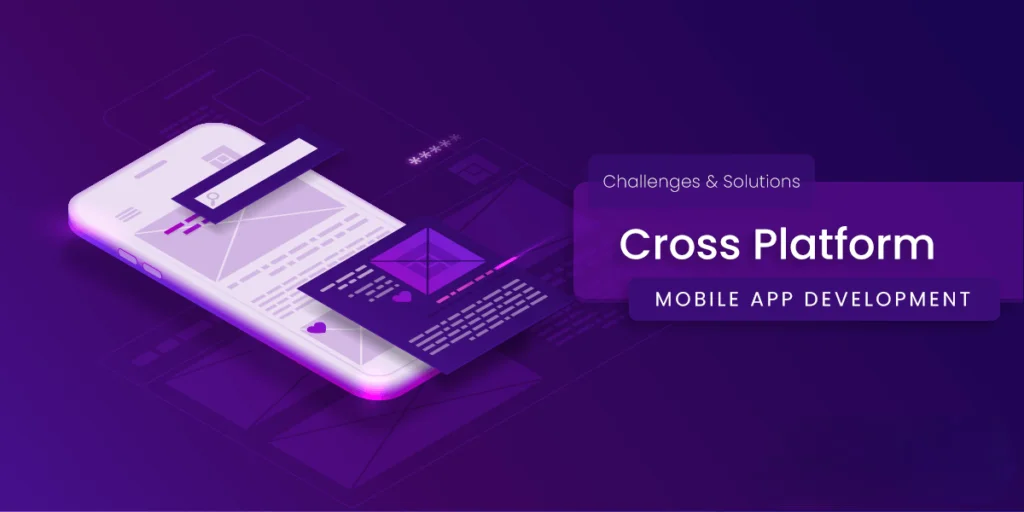The Challenges and Solutions of Cross-Platform Web and App Development
In the present digital era, companies are relying more and more on online and mobile applications to interact with their consumers and enlarge their distance. But creating programs that function properly on several platforms can be challenging. An in-depth analysis of the issues faced in multi-platform web and app development is provided in this article, in addition to a conversation about potential resolutions.

Understanding Cross-Platform App Development
Understanding cross-platform App Development is crucial before we look at the difficulties and solutions. Creating schedules that run well across several media, including iOS, Android, and additional web browsers, is understood as a cross-platform product. A consistent user experience must be provided across all of these platforms while requiring the least amount of App Development time and money.
Complexity in User Interface Design
Developing a user interface that adapts intrinsically to various gadgets and screen dimensions is one of the main concerns in cross-platform products. It is challenging to provide a consistent interface that fulfills user expectations because each platform has its design constraints.
Developers can use responsive design concepts to solve this problem. The application’s user interface may adapt dynamically dependent on the user’s device, offering the best viewing experience, by employing flexible layouts, graphics, and CSS media queries.
Performance Optimization
Performance optimization is a crucial factor that influences cross-platform App Development. Because the individual platform has additional performance conditions and constraints, it’s essential to fine-tune the application for optimum responsiveness and acceleration.
Developers should use techniques like code optimization, caching, and reducing network queries to improve performance. The performance of the application as a whole can be considerably enhanced by utilizing native features and hardware acceleration.
Code Reusability and Maintainability
Multiple codebases for various platforms require upkeep, which can be laborious and error-prone. Code reuse and maintainability must be ensured if App Development is to be sped up and defect risk reduced.
Developers can write code once and publish it across many platforms by leveraging cross-platform App Development frameworks and libraries like React Native or Flutter. This strategy streamlines maintenance activities while also saving time.
Platform-Specific Functionality
Even though cross-platform programming aims for uniformity, there are times when apps must make use of platform-specific features. For each platform, a distinct implementation can be needed, for instance, to access device hardware like the GPS, camera, or push notifications.
Developers can design abstraction layers that communicate with platform-specific APIs to address such problems. As a result, the program can make use of platform-specific capabilities while maintaining platform-neutral core logic.
Testing Across Different Platforms
To guarantee that the program runs smoothly across several platforms, thorough testing is essential. However, testing across various hardware, software, and browsers can be time- and resource-consuming.
Developers can use automated testing using Appium or Selenium tools to solve this problem. Automation can assure more test coverage and greatly speed up the testing process, spotting possible problems early in the App Development cycle.
Security Concerns
App Development for several platforms raises new security issues. If not adequately fixed, vulnerabilities in one platform could affect the overall application. For better security, developers should follow safe coding instructions, conduct regular audits of security, and keep current with security updates for third-party frameworks and libraries.
App Store Approval Process
Navigating through each platform’s unique clearance procedures is necessary for publishing applications in app stores. To prevent delays in the app’s deployment, it is crucial to ensure compliance with each platform’s rules. Developers who intend to launch their apps on app stores should carefully check their policies and take proactive measures to correct any potential violations while still in the design phase.
Continuous Integration and Deployment
For cross-platform App Development, effective continuous integration and deployment techniques are essential. The release process is streamlined and a quicker time-to-market is guaranteed by the ability to automate the build, test, and deployment procedures. Putting in place a solid CI/CD pipeline helps speed up development processes and lower the possibility of mistakes occurring during deployment.
Staying Updated with Platform Changes
Platforms are always changing, and new upgrades may bring about adjustments that influence an application’s performance or compatibility.
Developers that want to stay ahead should keep up with platform updates, SDK updates, and new best practices. By regularly updating the application, users can benefit from the newest features and upgrades while also avoiding compatibility problems.
Embracing Progressive Web Apps (PWAs)
The gap between web and native mobile applications is now being filled by progressive web apps (PWAs). PWAs offer the functionality of web applications and the immersive experience of native apps, combining the best of both worlds. They can be loaded on the user’s device like a typical app and viewed using a web browser.
PWAs can offer offline support and quick load times by utilizing service workers and caching methods, resolving some of the major issues with cross-platform App Development. PWAs are a popular option for businesses trying to grow their consumer base since they offer a uniform user experience across all platforms, devices, and browsers.
Harnessing the Power of Cloud Technologies
The manner that applications are created, deployed, and managed has been completely transformed by cloud technologies. These platforms provide functions like containerization, serverless computing, and database administration, allowing developers to concentrate on creating the essential features of the application rather than handling infrastructure. Businesses can easily react to changing consumer needs because of the scalability and seamless integration offered by cloud-based solutions.
Considering Voice-Enabled Applications
Through the usage of these applications, people can communicate with technology in a convenient, hands-free manner. Voice technology can be incorporated by developers to improve accessibility and engagement in cross-platform applications. Apps with voice functionality might be especially useful for users who have limited mobility or want a more natural user experience.
Ensuring Data Privacy and Compliance
When managing personally identifiable data, cross-platform software must respect user confidentiality and abide by rules like the European Union’s General Data Protection Control, or GDPR. Businesses may suffer serious ramifications as a result of data breaches and privacy violations, including harm to their brand and legal issues.
Data security must be a top priority for developers right away. User data can be protected by implementing encryption, access controls, and secure authentication techniques. The application’s compliance with the essential data protection requirements can be ensured by routine security audits and compliance evaluations.
Continuous Learning and Skill Development
As a result of the rapid advancement of technology, developers must stay current. To effectively overcome difficulties in cross-platform programming, ongoing learning and skill growth are necessary.
By partaking in seminars, meetings, and online courses, innovators can stay up to date on the most current creations and industry benchmarks. Skills and problem-solving aptitudes can be further improved by working together with other developers in the community and exchanging knowledge.
Leveraging Artificial Intelligence and Machine Learning
Thanks to the advancements in apparatus learning (ML) and manufactured cleverness (AI), cross-platform programming is encountering a revolution. These tools can be used to boost application performance, sped up development procedures, and improve user experiences.
For instance, chatbots powered by AI can offer people immediate assistance while effectively resolving their questions and issues. To give personalized recommendations and content, ML algorithms can examine user behavior and preferences.
Additionally, AI-driven automation can shorten the App Development cycle and increase overall efficiency by accelerating testing, problem-finding, and code generation. Businesses can get a competitive edge in the market and provide cutting-edge cross-platform solutions by integrating AI and ML.
User-Centric Approach
Businesses must keep a user-centric perspective in the quest to surpass rivals and succeed in cross-platform development. It’s crucial to have a solid awareness of the wants, issues, and expectations of the target need when creating apps.
Usability testing and regular user feedback should be an essential component of the App Development process. Businesses can develop applications that adapt to user preferences and offer an amazing user experience by actively listening to user feedback and making adjustments in response.
Collaboration with Industry Experts
Businesses experimenting with cross-platform App Development might greatly benefit from working with industry experts and experienced developers. Experienced experts bring insightful ideas and a lot of expertise to the table, assisting firms in avoiding mistakes and making wise decisions.
Making connections with industry leaders and enlisting the help of specialized App Development firms can hasten learning and result in the production of high-caliber cross-platform applications.
Performance Monitoring and Analytics
Continuous improvement requires key techniques like analytics data collection and application performance monitoring. Businesses can spot areas that need improvement by monitoring important performance measures like load times, user engagement, and conversion rates.
Analytics data can also show trends in user activity, enabling companies to customize their cross-platform applications to accommodate particular customer preferences. Data-driven decision-making can benefit from the useful insights that services like Google Analytics and Firebase offer on user interactions.
Staying Ahead of Security Threats
Businesses must continue to be diligent in guarding against potential security breaches in their cross-platform apps as cyber-attacks become more sophisticated. To find and fix such flaws, regular security audits, penetration tests, and vulnerability assessments are essential.
Furthermore, the application’s defenses against cyberattacks can be strengthened by staying current with security developments and implementing industry-standard security procedures.
Embracing Cross-Platform Frameworks
Creating apps that run smoothly across several platforms is rendered simple by cross-platform development tools like React Native, Flutter, and Xamarin. These frameworks make it possible to reuse code, saving resources and development time.
Businesses may speed up the App Development process and provide users with reliable applications by choosing the best cross-platform framework for their purposes.
Conclusion
Cross-platform web and app App Development present a special set of difficulties, but these difficulties are surmountable with the correct approaches and tools. Businesses may develop robust apps that provide a consistent user experience across a range of devices and platforms by understanding the intricacies of each platform, optimizing performance, guaranteeing code reuse, and putting a strong emphasis on security and testing. Adopting cross-platform development can assist companies in reaching a wider audience and thriving in the cutthroat digital environment.


